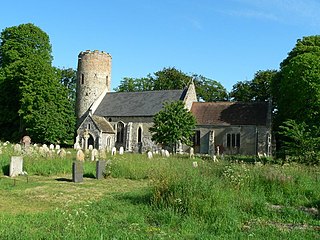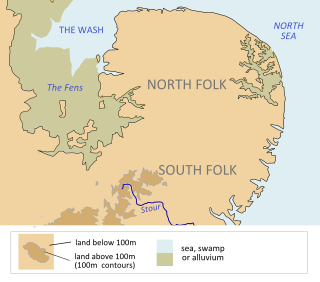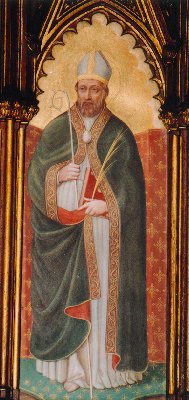
Rædwald, also written as Raedwald or Redwald, was a king of East Anglia, an Anglo-Saxon kingdom which included the present-day English counties of Norfolk and Suffolk. He was the son of Tytila of East Anglia and a member of the Wuffingas dynasty, who were the first kings of the East Angles. Details about Rædwald's reign are scarce, primarily because the Viking invasions of the 9th century destroyed the monasteries in East Anglia where many documents would have been kept. Rædwald reigned from about 599 until his death around 624, initially under the overlordship of Æthelberht of Kent. In 616, as a result of fighting the Battle of the River Idle and defeating Æthelfrith of Northumbria, he was able to install Edwin, who was acquiescent to his authority, as the new king of Northumbria. During the battle, both Æthelfrith and Rædwald's son, Rægenhere, were killed.

Burgh Castle is a village and civil parish in the English county of Norfolk. It is situated on the east bank of the River Waveney, some 3.7 miles (6.0 km) west of Great Yarmouth and within the Norfolk Broads National Park. The parish was part of Suffolk until 1974.
Æthelhere was King of East Anglia from 653 or 654 until his death. He was a member of the ruling Wuffingas dynasty and one of three sons of Eni to rule East Anglia as Christian kings. He was a nephew of Rædwald, who was the first of the Wuffingas of which more than a name is known.

Anna was king of East Anglia from the early 640s until his death. He was a member of the Wuffingas family, the ruling dynasty of the East Angles, and one of the three sons of Eni who ruled the kingdom of East Anglia, succeeding some time after Ecgric was killed in battle by Penda of Mercia. Anna was praised by Bede for his devotion to Christianity and was renowned for the saintliness of his family: his son Jurmin and all his daughters – Seaxburh, Æthelthryth, Æthelburh and possibly a fourth, Wihtburh – were canonised.

Gertrude of Nivelles, OSB was a seventh-century abbess who, with her mother Itta, founded the Abbey of Nivelles, now in Belgium.

May 1 - Eastern Orthodox Church calendar - May 3
Ecgric was a king of East Anglia, the independent Anglo-Saxon kingdom that today includes the English counties of Norfolk and Suffolk. He was a member of the ruling Wuffingas dynasty, but his relationship with other known members of the dynasty is not known with any certainty. Anna of East Anglia may have been his brother, or his cousin. It has also been suggested that he was identical with Æthelric, who married the Northumbrian princess Hereswith and was the father of Ealdwulf of East Anglia. The primary source for the little that is known about Ecgric's life is Historia ecclesiastica gentis Anglorum, written by the English Benedictine monk Bede in around 731 AD.

The Wuffingas, Uffingas or Wiffings were the ruling dynasty of East Anglia, the long-lived Anglo-Saxon kingdom which today includes the English counties of Norfolk and Suffolk. The Wuffingas took their name from Wuffa, an early East Anglian king. Nothing is known of the members of the dynasty before Rædwald, who ruled from about 599 to c.624. The Viking invasions of the 9th century and Dissolution of the monasteries in the 16th century both led to the destruction of documents relating to the rule of the Wuffingas.

January 15 - Eastern Orthodox liturgical calendar - January 17
Ultan was an Irish monk who later became an abbot. He was the brother of Saints Fursey and Foillan. He was a member of Fursey's mission from Ireland to East Anglia in c. 633, and lived there both as a monastic probationary and later alone as an anchorite. In c. 651 he accompanied his brother Foillan to Nivelles in Merovingian Gaul where they continued their monastic life together.

In the seventh century the pagan Anglo-Saxons were converted to Christianity mainly by missionaries sent from Rome. Irish missionaries from Iona, who were proponents of Celtic Christianity, were influential in the conversion of Northumbria, but after the Synod of Whitby in 664, the Anglo-Saxon church gave its allegiance to the Pope.

Felix of Burgundy, also known as Felix of Dunwich, was the first bishop of the kingdom of the East Angles. He is widely credited as the man who introduced Christianity to the kingdom. Almost all that is known about him comes from the Ecclesiastical History of the English People, completed by the English historian Bede in about 731, and the Anglo-Saxon Chronicle. Bede wrote that Felix freed "the whole of this kingdom from long-standing evil and unhappiness".
Sigeberht of East Anglia, was a saint and a king of East Anglia, the Anglo-Saxon kingdom which today includes the English counties of Norfolk and Suffolk. He was the first English king to receive a Christian baptism and education before his succession and the first to abdicate in order to enter the monastic life. The principal source for Sigeberht is Bede's Ecclesiastical History of the English People, which was completed in the 730s.

Eni or Ennius was a member of the Wuffing family, the ruling dynasty of the kingdom of East Anglia. He was the son of the semi-historical pagan king Tyttla and the brother of Rædwald, who both ruled East Anglia.
Æthelwold, also known as Æthelwald or Æþelwald, was a 7th-century king of East Anglia, the long-lived Anglo-Saxon kingdom which today includes the English counties of Norfolk and Suffolk. He was a member of the Wuffingas dynasty, which ruled East Anglia from their regio at Rendlesham. The two Anglo-Saxon cemeteries at Sutton Hoo, the monastery at Iken, the East Anglian see at Dommoc and the emerging port of Ipswich were all in the vicinity of Rendlesham.

Saint Foillan is an Irish saint of the seventh century.

Dommoc, a place not certainly identified but probably within the modern county of Suffolk, was the original seat of the Anglo-Saxon bishops of the Kingdom of East Anglia. It was established by Sigeberht of East Anglia for Saint Felix in c. 629–631. It remained the bishopric of all East Anglia until c. 673, when Theodore of Tarsus, Archbishop of Canterbury, divided the see and created a second bishopric at either North Elmham, Norfolk, or South Elmham, Suffolk. The see of Dommoc continued to exist until the time of the Viking Wars of the 860s, after which it lapsed.
Hereswith or Hereswitha, also spelt Hereswithe, Hereswyde or Haeresvid, was a 7th-century Northumbrian saint. She married into the East Anglian royal dynasty and afterwards retired to Gaul to lead a religious life. Hereswith's sister was Saint Hilda, founder of the monastery at Whitby. Details of her life and identity come from Bede's Historia Ecclesiastica, the Anglian collection and the Lives of Edwin of Northumbria and Hilda of Whitby.
Cnobheresburg was a castrum in East Anglia, where in about 630 the first Irish monastery in southern England was founded by Saint Fursey, as part of the Hiberno-Scottish mission described by Bede.

October 30 - Eastern Orthodox liturgical calendar - November 1












